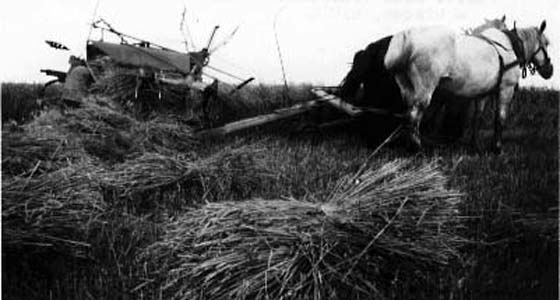Search | Image Archive | Reference | Communities | POV | Lesson Plans | Credits
 One of the problems that faced farmers moving to the Canadian Prairies was the short growing season. Varieties of wheat that were successful in the Ontario, the Unites States and in Europe proved less suitable to the Canadian prairies, where they were often ruined by early frost. Farmers recognized early that they needed a variety that germinated quickly and ripened early enough to beat the frost.
One of the problems that faced farmers moving to the Canadian Prairies was the short growing season. Varieties of wheat that were successful in the Ontario, the Unites States and in Europe proved less suitable to the Canadian prairies, where they were often ruined by early frost. Farmers recognized early that they needed a variety that germinated quickly and ripened early enough to beat the frost.
In the 1880s, debates raged in the agricultural press over the suitability of various seed types, but in the 1890s, a hard wheat called Red Fyfe (also spelled "Fife") prevailed in scientific tests conducted at the Dominion Experimental Farm in Brandon. Red Fyfe soon became the dominant variety grown on prairie farms.
While Red Fyfe took a little longer to mature than soft wheat varieties and was vulnerable to smut infection, it yielded a very dry, white flour that brought top dollar on the international market, and the bigger profits more than offset the risks for most farmers. Although Red Fyfe predominated through the first decade of the twentieth century, because of its its late ripening and tendency to be severely damaged by frost, farmers never ceased their search for an early ripening variety that would produce the kind of flour the market wanted. Again, the role of the federal government experimental farms was decisive, and in 1912, tests conducted at Brandon proved that a new variety called Marquis was superior to Red Fyfe in all respects.
Marquis was a hybrid developed by horticulturalists at the Central Experimental Farm in Ottawa in 1906. In the Brandon experiments, the Marquis matured in 107 days, as compared to 134 days for Red Fyfe, and it yielded 45 bushels per acre where Red Fyfe produced only 31. With endorsement and promotion from the government, Marquis quickly became the "flagship" crop and remained the dominant variety of Canadian wheat until after the Second World War.
Page revised: 27 August 2009